4.5 The relevance of early music in Cuban music.

In 1994, the early music ensemble Ars Longa was founded, and research into Cuban musical heritage preserved in church collections was renewed. Research and performing talent led from the outset to the rescue of old scores by this Early Music Ensemble, which belongs to the Office of the Historian of the City of Havana.
After an intense study of historical circumstances and interpretive possibilities, Ars Longa performs lost music, now being rescued, from the choirmasters of the Havana Cathedral (Calle Empedrado 156, Old Havana) and early music from Europe and America. The results of this work are evident in their three albums: El eco de Indias, featuring American Baroque repertoire; Música sacra en La Habana Colonial; and Los caminos del Barroco.
The Ars Longa Ensemble has contributed to the enrichment of contemporary Cuban music. It represents an important step in the dissemination and enjoyment of a music that is almost entirely unknown. But it’s not just a matter of historical value; from an aesthetic point of view, we are in the presence of master musicians whose art is intensely rich and evocative. Anyone who enjoys the privilege of listening to their works cannot help but thank them for having given us the best of themselves: their music.
Ars Longa is a group of young musician-actors who have come to occupy a privileged place in the realm of our cultural events. A broad repertoire from “bygone times” has been resurrected thanks to the intelligent research, astute adaptation, and tenacious work of a coherent collective, with sharp sensitivity and great histrionic resources. Subtle human voices and skilled handling of ancient musical instruments transport us to a world of transparent sounds, distant in time and space. The richness of theatrical expressions, the costumes, the alternation of voices and instruments, the spatial movement in which they perform, and the individual gestures all reach a high professional level.
Harold Gramatges








